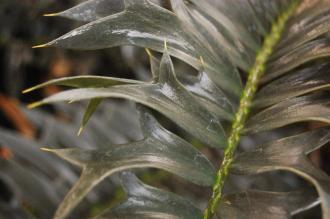
Encephalartos horridus (16/02/2016, Kew Gardens, London)
Position: Full sun
Flowering period: Late spring to early summer
Soil: Moist, well drained
Eventual Height: 90cm
Eventual Spread: 1.2m
Hardiness: 9a, 9b, 10a, 10b, 11
Family: Zamiaceae
Encephalartos horridus is a slow growing, evergreen, palm like shrub. Its blue/ green leaves are up to 1m long, arching and its leaflets are sharply spiny. Its may form a short trunk which may achieve a diameter of up to 30cm, the majority of which is below ground. Its flowers are dioecious. Its brown male strobili (cone like structures) are cylindrical, up to 40m long and 12cm across. Its brown female ‘cones’ are egg shaped, up to 40cm long and 20cm across.
Encephalartos horridus, commonly known as Eastern Cape Blue Cycad, is native to Eastern Cape Province, South Africa. In its native habitat it grow in arid scrub land on shallow soils. This plant is classified as Endangered according to the IUCN Red List of Threatened Species.
The etymological root of the binomial name Encephalartos is derived from the Greek en meaning ‘in’, kefalos meaning ‘head’ (brain) and artos meaning ‘cake’. Horridus is derived from the Latin horridum meaning ‘ bristly’, in reference to its leaves.

Encephalartos horridus Leaf (16/02/2016, Kew Gardens, London)
The landscape architect may find Encephalartos horridus useful as an unusual specimen shrub. Once established this shrub is drought tolerant. Care should be taken when locating this plant as it is extremely spiny.
Ecologically, Encephalartos horridus may be attractive to pollinating insects.
Encephalartos horridus prefers moist, fertile, well-drained soils. It prefers an acid to neutral pH of soil. It will not tolerate wet soils.
Encephalartos horridus requires little maintenance.

Landscape Architecture

